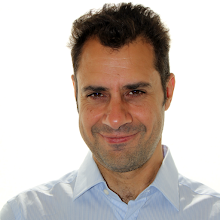Naive, non-accurate atmospheric scattering technique, together with non-accurate shadow volumes, in forward rendering. That means that all happens in the fragment shader in 1 pass.
All started with the need to place the sun in the sky, see the direction of the source light and confirm the accuracy of a procedural displacement mapping technique, with regard to addictional generated normals. That's why in this video there is still a close focus on rocks, pebbles, cracks, that appears correctly displaced and lit. The camera flies up to few centimeters from surfaces and yet triangles/texels are scarcely visible.
This procedural displacement mapping is a technique that resembles the notable "micropolygons" technique in use at Pixar for cinematographic rendering. The difference is that here these micropolygons cover a screen area averagely close to the pixel area but not less than the pixel area. This little difference makes a huge difference in the correct per-vertex normal calculation, that can't be simplified as in the original micropolygons technique. Neverstanding, the quality of displacement is still appreciable and performances affordable in modern gaming video cards.
Yes, another huge difference is that this procedural (on-the-fly) displacement mapping technique is real-time.
The sky is currently rendered as a quad. Part of the code of light scattering is present in both sky shader and terrain shader. This solution allows 1 pass, although it's not possible to take advantage of deferred rendering for other interesting effects, such as glow or lens flare (maybe). However, even if in form non strictly accurate, gdevice rendering currently has 4 important features of light: direct radiation, indirect radiation, reflected radiation, volumetric shadows.
Cubemap may come furtherly, together with procedural clouds generation, that I have in mind to be volumetric too (that's why it will plausibly come up to a 3D texture instead).
At this point gdevide runs only on OpenGL 4.30 profile. Other profiles have been dismissed and code branches progressively eliminated. However the terrain engine is still the one I used on OpenGL 1.2 for multitextured terrain, up to a 30 km view, 16x16 vertices per squared meter (total 10^11 vertices coverage), with no impostering and not any culling (not yet, until this LOD technique suffices).
Terrain is now GPGPU generated by means of a compute shader. The pipeline is a pure attributeless pipeline. And yes, I'm slowly getting my feet wet with modern rendering techniques.
skip to main |
skip to sidebar

View my LinkedIn profile
 gdevice
gdevice
by Pietro De Nicola
is licensed under a
Creative Commons Attribution-NonCommercial-NoDerivs 3.0 Unported License.
About
I wanted to learn about 3D engines.
The result is gdevice, a framework developed from scratch, by means of C++ and OpenGL.
See mindmap
Gdevice has soon turned into a beautiful exercise in evading conventional solutions and finding new ways to do things. It has brought me to explore techniques from diverse domains, such as demoscene, cinematographic rendering, interactive 3D graphics, mainly converging to real-time procedural generation and experimental rendering techniques.
A video demo is available here.
This blog is where I save random notes about this hobbistic activity.
If you like what I do or have found useful stuff in here or just feel this world would be a better place by giving creative individuals the way to express themselves, please donate.
Your donations have a real effect on how much time I can dedicate to developing gdevice. Thank you.
Show less
The result is gdevice, a framework developed from scratch, by means of C++ and OpenGL.
See mindmap
Gdevice has soon turned into a beautiful exercise in evading conventional solutions and finding new ways to do things. It has brought me to explore techniques from diverse domains, such as demoscene, cinematographic rendering, interactive 3D graphics, mainly converging to real-time procedural generation and experimental rendering techniques.
A video demo is available here.
This blog is where I save random notes about this hobbistic activity.
If you like what I do or have found useful stuff in here or just feel this world would be a better place by giving creative individuals the way to express themselves, please donate.
Your donations have a real effect on how much time I can dedicate to developing gdevice. Thank you.
Show less
Search
-
September 2023
(1)
-
April 2014
(1)
-
November 2013
(1)
-
May 2013
(1)
-
September 2011
(1)
-
June 2010
(1)
-
May 2010
(1)
-
March 2010
(1)
-
January 2010
(1)
-
December 2009
(1)
-
November 2009
(1)
-
October 2009
(1)
-
September 2009
(3)
-
August 2009
(1)
-
August 2008
(2)
- September 2023 (1)
- April 2014 (1)
- November 2013 (1)
- May 2013 (1)
- September 2011 (1)
- June 2010 (1)
- May 2010 (1)
- March 2010 (1)
- January 2010 (1)
- December 2009 (1)
- November 2009 (1)
- October 2009 (1)
- September 2009 (3)
- August 2009 (1)
- August 2008 (2)
About Me

- Pietro De Nicola I have developed engineering in various application scenarios, such as television, mobile, web, telecom, embedded, defense, aerospace, artificial intelligence, videogames, CAD, CAM, among others. I have had a key role in designing processes, researching, developing new algorithms, prototyping, optimizing. My core competences lie in real-time, high-performance software, parallel computing, computational geometry, 3D graphics and I’m passionate about everything related to modern rendering.
View my LinkedIn profile
Pageviews
Copyright
by Pietro De Nicola
is licensed under a
0 Comments: